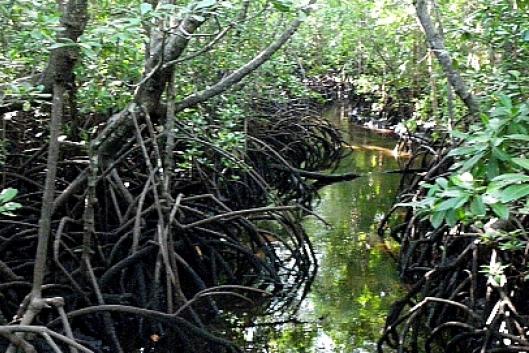The land grabbing effect of conservation projects is rarely considered in the current discussion of global ‘land grabbing’. In Tanzania, where around 40 % of the land area of the country is under some form of environmental protection, conservation areas have steadily increased since colonial times, leading to loss of land and access for small‐scale farmers, pastoralists and fisherfolk.
Tanzania has a coastline of over 800 km, characterised by a wide range of biotopes including mangrove forests. These mangrove forests provide habitats supporting the highest marine biodiversity in eastern Africa. They also provide the livelihood basis for fishers in coastal villages and towns while small‐scale fisheries provide important protein‐rich food to coastal populations, and account for 95% of the fish catch.
However, coastal tourist facilities are occupying increasingly extensive stretches of the most attractive shorelines. Initial proposals for marine conservation areas were proposed in 1968, followed by the passing of the Fisheries Act of 1970 by the Tanzanian Parliament, and with the promulgation of seven small marine reserves near Dar es Salaam, Tanga and Mafia.
However, the regulations and the enactment of these reserves were not actually translated into practice for more than 25 years. In the late 1980s and early 1990s, community leaders in Mafia Island complained of destructive fishing practices (through the use of dynamite explosives) perpetrated by outsiders.
The "Marine Parks and Reserves Act" was passed in November 1994 and the Park was gazetted in April 1995. In 1994, the Fisheries Division received funding from Norad, and WWF simultaneously showed a keen interest in playing a role as technical adviser towards the establishment and implementation of Mafia Island Marine Park (MIMP) off the coast of Tanzania. In spite of the participatory intentions stated, and the popularity of the initial successes in collaborating with local communities in order to halt the destructive and unpopular practice of dynamite fishing, the long‐term emphasis of MIMP is clearly also on promotion of new economic activities.
Mafia Island Marine Park covers an area of 822 square kilometres, and it is the biggest marine park in the Indian Ocean. The park encompasses 10 villages and is inhabited by approximately 15,000 to 18,000 residents of whom 45‐65 % rely heavily on marine resources for their livelihoods. Mangroves and coastal forests lie in the "core zones", where fisherfolk and inhabitants are not allowed to access resources at all, despite these areas being the richest traditional fishing grounds, whilst tourists, hotel businesses and researchers are allowed to visit, dive, snorkel and conduct research there. There are "specified use zones" in which fishers are only allowed to use certain types of fishing gear (hand‐lines and basket traps) and fishing by non‐residents is prohibited while the remaining areas are referred to as "general‐ use zone" in which net fishing is allowed, but mesh‐sizes are more restricted than in general coastal waters.
Despite claims about the participatory process towards the formulation of the General Management Plan, and the phrases about community‐based conservation, the Plan was published in the English language and was not translated into Kiswahili for seven years. Statements about community‐based conservation and co‐management did have some meaning in the consultative period prior to the formation of MIMP, and in the initial period of collaboration with villagers to combat dynamite fishing, but in subsequent years have become mainly rhetorical.
The MIMP administration became larger and larger, and internal administration, contact with national authorities and emphasis on patrolling and reinforcement of a "policing" role has become more prominent.
Though some Mafia residents gain markets to sell products to the hotels, and to MIMP staff, others actually gain opportunities for employment, and some provide guest‐house facilities for visiting researchers, the better‐paid jobs in the marine park administration and the tourism hotels are mainly awarded to people from outside Mafia or to foreigners.
All in all, the benefits mainly accrue to the State, to foreign‐owned tourism enterprises, and to visiting foreign tourists, whilst local communities witness some gains but they have lost access to former traditionally governed and utilised ecosystems including mangrove forests. Many fisherfolk and villagers from within the park express disappointment and skepticism about the practice of conservation for these reasons.
In December 2008 and February 2010, MIMP patrol boats transported Army soldiers to some villages and leaders were beaten and all their fishing nets confiscated, both legal nets and ones newly defined as illegal. The latter incident led to considerable fear, food insecurity and impoverishment of the whole village community on the island of Jibondo, and caused much concern in other villages. This has led to a serious loss in people's respect for the legitimacy of the role of the State in relation to marine conservation. Similar incidents have occurred in other villages in Mafia and other parts of the Tanzanian coastline, and in August 2010, while trying to confiscate villagers' nets in the dark, Army soldiers shot two fishermen, killing one, before dawn in northern Tanzanian coastal village of Tongoni.
A new trend of displacement and accumulation is taking place along the coastline of Tanzania, where global actors pursue a new set of interests including biodiversity conservation, safari tourism, climate change mitigation, benefitting from cheaply acquired land yet these interests and the related investments come at the expense of the rural communities whose conservation interests related to securing their basic livelihoods, practiced over generations, are ignored.
Article adapted from “Conservation and Land Grabbing in Tanzania”, by Ian Bryceson, Tor A. Benjaminsen, Faustin Maganga and Tonje Refseth, at http://www.future-agricultures.org/papers-and-presentations/cat_view/1551-global-land-grab/1552-conference-papers?start=20
